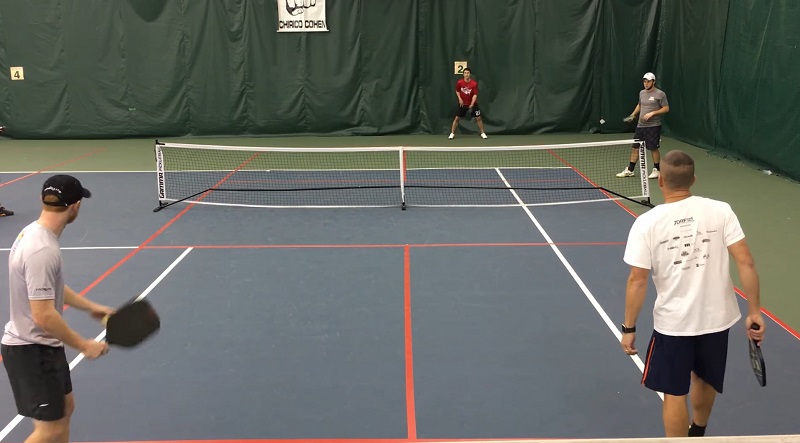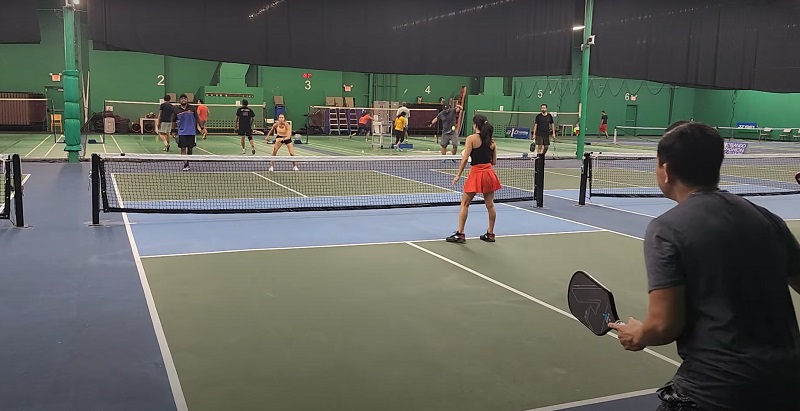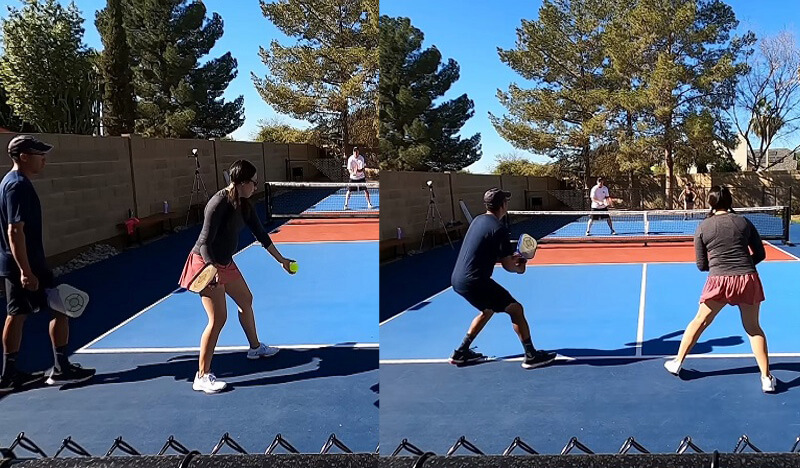Where to Stand – the Serving Team
The server should always stand toward the non-volley zone line (the right courtside if you’re right-handed). This will give them a better angle when they serve. It also helps to stay as close as possible to their partner while serving to allow better communication and ensure the court is covered.
When your partner is serving (make sure he/she is on the correct service court), there are two main positions for you to take as the non-server. First, stand no further than halfway between the service line and the baseline, closer to the net. This will allow you to better prepare for a return of serve from your opponents.
Second, stay in an athletic pickleball ready position to move quickly toward either side – this ensures that you can reach any shot hit by your opponents with minimal effort. When playing doubles pickleball serving team must be in sync when returning shots
Where to Stand as the Server
When playing pickleball doubles serving, it is important that the serving team stand in the back row when serving in pickleball. This allows you and your partner to cover more area to return any potential shots that may head toward either side. It also gives you a better chance of returning serves from opponents as well as attacking their weaker areas.
The position of your partner depends on whether or not you have an offensive or defensive style of play. If you want to be more aggressive, your partner should take a position around the center of the court between both no-volley lines. This puts them closer to being able to attack the ball if it is returned.
If you prefer a more defensive style, your partner should take a position slightly behind you and around the service line; this gives them the freedom to move in either direction to hit an aggressive strike back or block a shot attempt by their opponents.
Finally, remember to stay low while serving. By doing this, you can avoid being blocked by your opponent and have a better chance of making an accurate serve. Make sure that you are lined up correctly with your partner so that quick decisions can be made when attacking or defending against your opponent’s shots.
Where to Stand as the Server’s Partner
When your partner is serving in pickleball, it’s important to stand. Positioning plays a significant role in the game and can give you an advantage over your opponents. Here are some pickleball tips on where to stand when your partner is serving:
1) Stand behind the baseline
This will allow you to have better control of the court and help you set up for a potential return shot. Additionally, standing behind the baseline will enable you to make quick cuts or dives toward the net if necessary.
2) Move around judiciously
Don’t remain stationary while your partner is serving; instead, move lightly around so that your opponents can’t predict where you’ll be. This will make it more difficult for them to time their shots and increase your chances of returning the ball with ease when they hit it toward you.
3) Stand in the right spot
After every shot, move your feet so that you’re standing in the right spot. This means standing just inside or next to the sideline if you are returning a wide-angle shot, and standing directly away from the net (at least 5 feet away) if you’re returning a deep shot near the kitchen line. Make sure to stay out of your partner’s way as well.
By following these tips on where to stand when your partner is serving in pickleball, you can gain an edge over your opponents and improve your performance.
Where to Stand – Returning Team
When returning shots, it’s important for the return team to understand when to move, and where to move. Generally, the players on the serving team move diagonally from their partner to cover as much of the court as possible. The player closest to the net should stay close and be ready for any volleys The farther back you are, the more time you have to position yourself on the court.
The player furthest away from the net needs to maintain a mid-court positioning when returning shots. This allows them enough time to react and move into position if needed. It also prevents them from getting pinned down close to the kitchen line or baseline. When your partner is serving, move out of the way so that the server has plenty of room to hit their shot.
The main goal when returning shots is to keep your positioning balanced on the court. This requires a good understanding of where you should be in relation to your partner and the net. Knowing this will help ensure that you can cover as much of the court as possible while still giving yourself enough time to make an effective return.
Try not only practicing your technique but also your footwork and positioning by playing different opponents and styles of play to truly become a master at where you should position yourself in pickleball!
Where to Stand as the Receiver
As the receiver, you should position yourself where you can access any shot and anticipate your opponent’s return. Stand near the center of the court, with one foot slightly ahead of the other for balance; this will provide you with better vision and control over your shots.
If your partner is serving, remain slightly behind them but close enough that you can see their serve and have time to get ready for returning. You should also stay close enough so that if needed, you can help take an angled or wide return from your teammate.
Where to Sand as the Receiver’s Partner
Where to stand as the receiver’s partner is also important. You should stand close to the kitchen line, preferably near the middle of the court. This will allow you to cover any shots that are hit deep or wide, as well as give you a better angle for returning the ball to your opponents.
You and your partner should be aware of each other’s movements so that neither one is left behind if their opponent hits an unexpected shot.
By understanding where to stand in pickleball, you can ensure that you and your team are always in a position to make great returns!
Where to Stand – Receiving the 3rd Shot
When it comes to where to stand in pickleball, the key is understanding how your partner’s serve affects your court positioning. After their second shot (or third if they are serving), you can shift your focus from returning the ball to anticipating where your next shot will come from.
When receiving a third shot, players need to understand that there are three main areas on the court to take into consideration: forecourt, midcourt, and backcourt. Depending on where the serve lands and what type of return shot is hit by your opponent, you should be looking to adjust your position accordingly.
In general, when playing doubles pickleball it is wise for one player to stay in the forecourt while their partner covers the backcourt. This allows players to cover more of the court and respond quickly to shots from their opponents.
For singles pickleball, knowing where to stand is a little more complicated as you are responsible for covering the whole court. When your opponent serves, take note of where it lands more often and adjust your position accordingly.
Advanced Strategies For Where To Stand In Pickleball – Stacking
Stacking is one of the advanced strategies for where to stand in pickleball. Stacking involves positioning yourself and your partner on opposite sides of the court. This places one player in front of each baseline, near the middle of the court.
When your partner is serving, you should move into a stacked position so that you are ready to defend against possible returns. You can also use this strategy before or after a point when it looks like either opponent might be setting up a return or lob shot.
Stacking can also be used when you and your partner have a weak forehand or backhand side. By stacking, both players can cover the net more effectively with their weaker side.
It’s important to practice stacking regularly so that you become comfortable with the strategy and know how to coordinate your movement with your partner.
What is Stacking?
Stacking is a term used to describe positioning in pickleball. When playing doubles, two players will stand on either side of the net and wait for their partner to serve. The players then “stack” themselves on one side of the court behind their respective partners who are serving.
The idea behind stacking is that it gives each player a better chance to cover more space when returning shots. Stacking can be especially beneficial when your opponents have good serving skills or when they hit tricky shots such as dinks or lobs.
By providing an extra set of eyes and hands, your team can be better prepared to react quickly to any shot that comes
How Does Stacking Work in Pickleball?
When stacking in pickleball, you should aim to stand near the center of your partner’s side of the court. This will give you a better chance to move quickly in either direction when returning shots. You also want to make sure that you don’t crowd your partner or get in their way as they prepare for their next shot.
Conclusion
Now that you know all the places to stand and what each offers, get out on the court and start practicing. The only way to really learn is through practice. Remember to know the serving rules, and have fun! After all, isn’t that what pickleball is all about? Players of all ages can enjoy this game – young or old, beginner or expert. So, what are you waiting for? Get moving and find your perfect spot on the court today!
Related Articles:
- The 15 Pickleball Tips for Intermediate Players You Need to Know
- 8 Simple Pickleball Tips For Beginners To Quickly Improve In-Game
- How To Keep The Ball Low In Pickleball: 11 Steps Low-ball Keeping
- How To Hit a Pickleball Harder: Topspin Hitting Technique
- How To Hold A Pickleball Paddle Like A Pro




